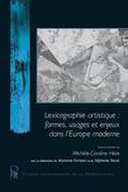Explore

Lexicographie artistique : formes, usages et enjeux dans l'Europe moderne/ Artistic lexicography : forms, uses and issues in Early Modern Europe
Dans des approches croisées, les thématiques développées dans cetouvrage apportent un regard neuf sur les formes, usages et enjeux de lalexicographie artistique à l’époque moderne. Dans une perspective de circulation des concepts et des pratiques, et deperméabilité des frontières artistiques, le mot se révèle être unprécieux laboratoire de l'exercice de la pratique artistique et un champd'exploration des réseaux culturels qui traversent et font l’Europe. À travers l'élaboration d'un langage, les livres sur l'art dont lespublications se multiplient au Nord des Alpes à partir de 1600, visent à laconstruction d'un savoir commun à l'usage des peintres et des amateurs.Leurs nombreuses traductions, publiées dès l'époque moderne, témoignentégalement de leur rôle d'agent de diffusion en constante adaptation aulectorat auquel ils s'adressent. Comprendre les stratégies et les processusd'invention et de transfert d’une terminologie spécifique àl’expression esthétique devient alors un enjeu important. Les mots, eneffet, ne sont pas interchangeables. En se succédant ou se superposant,même s'ils sont contradictoires, les différents sens donnent épaisseur etsubtilité au concept. Le voyage d'une notion dans le temps et dans l'espace contribue alors aussià un élargissement de notre compréhension d'une histoire culturelle entreuniversalité et identité au sein de la diversité artistique quicaractérise de l'Europe moderne. Dans des approches croisées, les thématiques développées dans cetouvrage apportent un regard neuf sur les formes, usages et enjeux de lalexicographie artistique à l’époque moderne. Dans une perspective de circulation des concepts et des pratiques, et deperméabilité des frontières artistiques, le mot se révèle être unprécieux laboratoire de l'exercice de la pratique artistique et un champd'exploration des réseaux culturels qui traversent et font l’Europe. À travers l'élaboration d'un langage, les livres sur l'art dont lespublications se multiplient au Nord des Alpes à partir de 1600, visent à laconstruction d'un savoir commun à l'usage des peintres et des amateurs.Leurs nombreuses traductions, publiées dès l'époque moderne, témoignentégalement de leur rôle d'agent de diffusion en constante adaptation aulectorat auquel ils s'adressent. Comprendre les stratégies et les processusd'invention et de transfert d’une terminologie spécifique àl’expression esthétique devient alors un enjeu important. Les mots, eneffet, ne sont pas interchangeables. En se succédant ou se superposant,même s'ils sont contradictoires, les différents sens donnent épaisseur etsubtilité au concept. Le voyage d'une notion dans le temps et dans l'espace contribue alors aussià un élargissement de notre compréhension d'une histoire culturelle entreuniversalité et identité au sein de la diversité artistique quicaractérise de l'Europe moderne. Dans des approches croisées, les thématiques développées dans cetouvrage apportent un regard neuf sur les formes, usages et enjeux de lalexicographie artistique à l’époque moderne. Dans une perspective de circulation des concepts et des pratiques, et deperméabilité des frontières artistiques, le mot se révèle être unprécieux laboratoire de l'exercice de la pratique artistique et un champd'exploration des réseaux culturels qui traversent et font l’Europe. À travers l'élaboration d'un langage, les livres sur l'art dont lespublications se multiplient au Nord des Alpes à partir de 1600, visent à laconstruction d'un savoir commun à l'usage des peintres et des amateurs.Leurs nombreuses traductions, publiées dès l'époque moderne, témoignentégalement de leur rôle d'agent de diffusion en constante adaptation aulectorat auquel ils s'adressent. Comprendre les stratégies et les processusd'invention et de transfert d’une terminologie spécifique àl’expression esthétique devient alors un enjeu important. Les mots, eneffet, ne sont pas interchangeables. En se succédant ou se superposant,même s'ils sont contradictoires, les différents sens donnent épaisseur etsubtilité au concept. Le voyage d'une notion dans le temps et dans l'espace contribue alors aussià un élargissement de notre compréhension d'une histoire culturelle entreuniversalité et identité au sein de la diversité artistique quicaractérise de l'Europe moderne.
This book is included in DOAB.
Why read this book? Have your say.
You must be logged in to comment.
Rights Information
Are you the author or publisher of this work? If so, you can claim it as yours by registering as an Unglue.it rights holder.Downloads
- 122 - pdf (CC BY-NC-ND) at OAPEN Library.
Keywords
- Art forms
- Art theory
- artistic lexicography
- artistic literature
- artistic practice
- artistic terminology
- European History
- Giorgio Vasari
- Giovanni Pietro Bellori
- History
- History of art & design styles: c 1600 to c 1800
- History Of Art / Art & Design Styles
- Humanities
- Karel van Mander
- Painting
- Painting & paintings
- Paris
- Regional & national history
- The arts
- The arts: general issues
- thema EDItEUR::3 Time period qualifiers::3M c 1500 onwards to present day::3MG 17th century, c 1600 to c 1699
- thema EDItEUR::3 Time period qualifiers::3M c 1500 onwards to present day::3ML 18th century, c 1700 to c 1799
- thema EDItEUR::A The Arts
- thema EDItEUR::A The Arts::AB The arts: general topics
- thema EDItEUR::A The Arts::AB The arts: general topics::ABA Theory of art
- thema EDItEUR::A The Arts::AF The Arts: art forms::AFC Paintings and painting
- thema EDItEUR::A The Arts::AG The Arts: treatments and subjects::AGA History of art
- thema EDItEUR::N History and Archaeology::NH History::NHD European history
- Theory of Art
Links
DOI: 10.26530/OAPEN_644313Editions

